Let’s imagine that you’ve decided to buy a new laptop. What determines your first steps on the way to the purchase? Where do you go to get the essential information? How do you define your budget? Which web sources would you visit to buy the laptop? And finally, would you prefer to shop online or visit a brick-and-mortar shop?
In this article, I’ll cover:
- An explanation of what multicultural marketing is
- Using programmatic tools for individualized ads
- Defining multicultural personalization points
- Personalizing your video marketing
- Delivering better content with blogging
So if you want to expand your digital advertising reach to include – rather than exclude – more people and, thus, get more traffic, read on!
What Exactly Is Multicultural Marketing?
The questions in my intro above are just a few that normally arise when we decide to buy something. If you’re doing Internet marketing, you need to remember that for each of these questions, consumers will give different answers. Surprisingly (or not), a lot of our decision-making depends on our individual experiences and cultural background.
Multicultural marketing enables brands to address people of various ethnicities and cultures more effectively, minimizing intrusion and misunderstanding. With the same overarching approach and brand experience, modern advertisers can learn how to deliver their message to diverse audience segments.
For successful international marketing and advertising, it is important to understand how customers make decisions. It is no less essential to realize that people in different areas may not have equal access to Internet sources. They face different life challenges and prioritize goods and services differently.
For instance, the fact that social media preferences vary by race and ethnicity has been illustrated in the Pew reports. According to them, African Americans and Hispanic Americans represent the most active users of TV, radio and mobile devices:
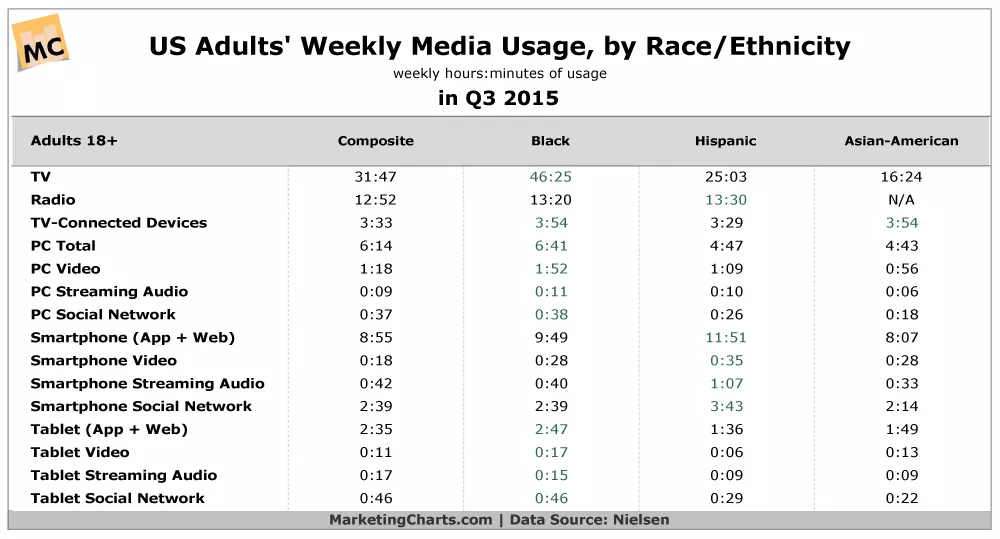
Segmenting by age goes on to show that multicultural millennials are the highest content consumers:
- 62% blogs
- 78% radio
- 89% TV
- 93% smartphones
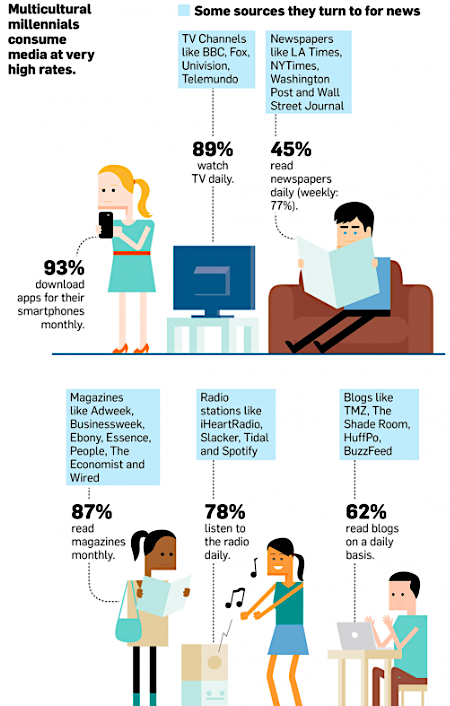
This segment represents 75 million people in the U.S., which makes it the largest population layer in the country. For exactly this reason, marketers have developed multicultural content personalization.
We’ve brought to you some of the most useful tactics of multicultural marketing – programmatic tools, content, video marketing and blogging tips – that will make your customers relate to the messages you deliver. Time to get started!
Use Programmatic Tools for Individualized Ads
Programmatic tools turn simple digital advertising into individualized digital advertising.
Programmatic advertising is the use of artificial intelligence and algorithms to buy and optimize ads in real-time.
For the multicultural marketing strategy, programmatic software is irreplaceable because it enables audience segmentation and targeting according to the language, area, IP, device type, channel, level of income, preferences, etc. of the target audience’s characteristics.
Define Your User Segments
DMP (data-management platform) is a unified customer database that helps collect comprehensive information regarding your target audience. Collecting detached data from a variety of media used by customers (website, in-app, email, social channels, etc.), the database arranges, unifies and transmits ready-made segments to connected DSP (demand-side platform) in order to enable omnichannel targeted advertising.
How is it different from any other unified user database? For starters, unlike CRM, DPM is not limited by first-party data (personal data that customers provide to the brand: name, email, cell phone, etc.). It’s also enriched with second- and third-party data aggregated by other worldwide resources (individual demographic characteristics, income level, family status, number of children per family, etc.). This type of data significantly increases the level of accuracy of targeted ads.
The Interactive Advertising Bureau states that 49.3% of data-centric organizations look for data centralization systems that provide predictive analysis and cross-channel measurement. Since DMP integrates all channels, this task becomes totally doable.
Although CRM databases enable the nurturing of existing multicultural prospects, DMP also pushes a campaign forward, working for customer acquisition (with DSP) and lookalike modeling:

Lookalike modeling takes into account the characteristics of existing customers in order to attract new ones. In the course of an advertising campaign, behavior and gathered user data is analyzed in real-time. Then, mathematical modeling interprets the results and the users with similar characteristics receive the ads.
Thus, the smart system reduces the average cost-per-customer acquisition by channeling ads to the people who are more likely to be interested in what you have to offer. For instance, a brand that produces organic food but only targets food makers and restaurant keepers might discover completely new audiences – people who are interested in losing weight or sports fans.
Dive Deeper:
- Segmentation 101: A Strategist’s Complete Guide to Marketing Segmentation
- 7 Killer Digital Advertising Trends Every Marketer Should Know in 2023
- How to Create the Ultimate Marketing Funnel (Templates Included)
Target Across Channels
Today, people spend a lot of time searching for products or services online. When they do, they use a variety of devices as we’ve already found from statistics. Omnichannel programmatic DSP (demand-side platform) allows marketers to reach consumers on smartphones, tablets, PCs, smart or connected TVs and other channels simultaneously.
Demand-side platforms automate media buying by purchasing target impressions on websites visited by a brand’s targeted customers. How? AI- and ML-based systems control the displays based on customer data and targeting options selected through the dashboard.
It is a common practice for multicultural campaigns to target audience segments according to language, geolocation, dayparting, IP and traffic type (channel). This way, an omnichannel DSP ensures that every ad impression is delivered to the right user, on the right screen and at the right moment when they’re most responsive.
Determining the right customers, the right spot and the right context for advertising, omnichannel programmatic increases reach, ROI and engagement, which is also very important. As practice shows, users who are engaged by omnichannel campaigns tend to spend 10% more time in online shops, and 23% more time in physical stores, compared to those who receive ads via one channel:
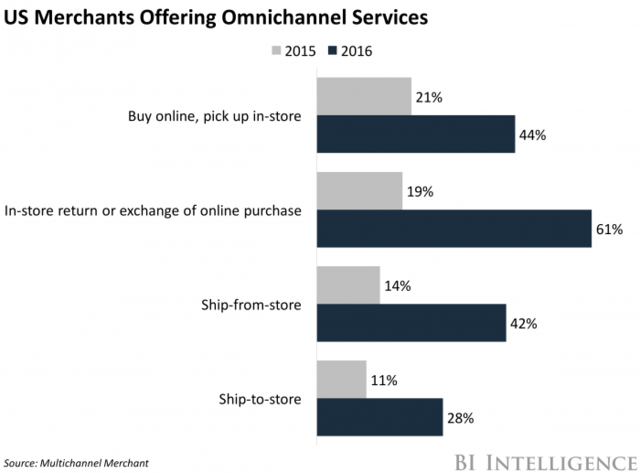
Learn More:
- How Artificial Intelligence Is Revolutionizing the Digital Marketing Sphere
- The Future of SEO: How AI and Machine Learning Will Impact Content
- How to Use Predictive Analytics for Better Marketing Performance
Define Multicultural Personalization Points
If you’re extending your customer base, plan to make the first brand experience of your new multicultural customers comfortable and relevant. Then on each point of interaction with your company, people will see that they are receiving what they really need.
There are numerous ways to personalize the customer experience for multicultural visitors. Most likely you will not have to start from scratch. Almost every business has a basic pool of information for sufficient content personalization: a database of email addresses, geodata, traffic type, etc. If not, it might be a good idea to “borrow” second- and third-party data from other companies using a data-management platform.
The good news is that:
58% of Americans surveyed by the American Direct Marketing Association (DMA) are willing to share their personal information with brands if it's in exchange for something valuable: bonuses, discounts and experience personalization. Share on XThis trend also works well for businesses: 86% of consumers are willing to pay more if their customer experience improves:

You can use various customer interaction points to improve this experience: email marketing, website, social networks or advertising. Keep in mind, however, that the path of each customer is unique and the way they perceive your message may be different from what you thought it would be.
That’s why before starting multicultural campaigns, marketers usually test the perception of features, functions and benefits on different audience segments with conjoint analysis. Conjoint analysis simulates real-life market decisions considering pricing, product features, variations and other important details.
Dive Deeper:
- Geotargeting: How to Find the Right Customers for Your Brand
- 3 Ways to Personalize the Customer Journey Experience
- The Complete Guide to Getting Started With Website Personalization
Personalize Video Marketing
As shown in the State of Personalization Report by Segment, retailers (not just in e-commerce, but across all industries) should be exceptionally quick to act when they personalize content for customers because users demand personalization within one hour of identifying themselves with the brand:
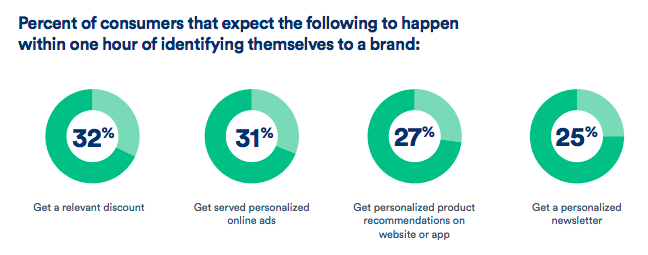
Technically, personalization is more complicated than it seems. In essence, this is an individualization of the site/app/TV content in real-time that should satisfy the unique needs of each visitor, gradually guiding them to conversion.
With a big shift towards mobile devices, where the share of video consumption is most significant, personalization is expected to be prevalent in video marketing. Embedded in a landing page, video can elevate conversions by 80% and increase the CTR of an e-mail by 200-300%.
Video marketing personalization strategies include a wide range of components, such as pop-ups, tips and product recommendations, but that’s not the end of the list. Video personalization can also be automated.
Using video marketing platforms, you can create dynamic pieces of video content that incorporate the data from your CRM and deliver relevant sales messages to your clients. Downloading your video to the DSP, you can expect full-scale programmatic personalization according to geo, language, time of the day, etc.
Presumably, you have representatives of different ethnicities on your team, so it’s always a good idea to test and assess the relevance and appropriateness of video content together in order to bulletproof it against possible misunderstandings.
Dive Deeper:
- The Ultimate Guide to Video Marketing
- A YouTube Video Marketing Guide to Increase Prospects in Your Funnel
- 7 Ways Video Helps Inbound Marketing
Deliver Content with Blogging
Since the 2000s, blogs have transformed into highly specialized media sources that speak for the interests and lifestyles of certain audience segments: tech minds, politics followers, mommies, celebrity gossip readers, healthy food enthusiasts, etc. Capturing the attention of narrow audience segments, such blogs actually gain large volumes of traffic.
Personalization is powered by large amounts of data, meaning that you have a lot of options to adjust blog content for your multicultural segments. The affinity categories report in Google Analytics can help you analyze common blog trends: which affinity segments drive the highest traffic, conversions and lowest bounce rate. The results can be surprising. You may find out that your best audience is actually people you never aimed to target.
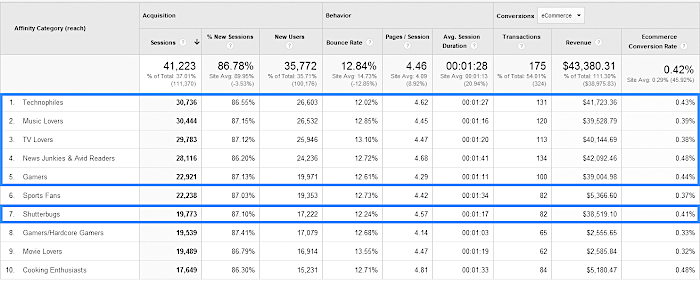
In the same way, you can determine your most popular content types by grouping your articles by categories or tags to discover the subjects that your audience finds most engaging.
If you have a DMP or other user database, you can also conduct audience analytics based on data obtained from external suppliers. Based on this data, you can develop content strategies for narrow audience segments and attract narrow niche traffic.
If you monetize your blog traffic with digital ads, this will significantly increase the impact of impressions. Thus, it will grow your blog’s traffic value and attract advertisers willing to pay a good price for impressions on your blog.
Dive Deeper:
- How to Build a High-Performance Content Marketing Strategy
- 7 Steps to Stardom: How to Direct Web Traffic to Your New Blog
- What Are the Best Blogging Platforms? (From Free to $$$)
The Takeaway
The best way to engage customers hailing from different cultural backgrounds is to find out what motivates them, what drives their purchase decisions and which digital environment they prefer to hang out in.
Multicultural marketing focuses on your most important asset: customers and their individualities. With modern technologies designed for analyzing, automating and personalizing the user experience, businesses can craft a robust marketing strategy that drives better efficiency and keeps all customers satisfied.






